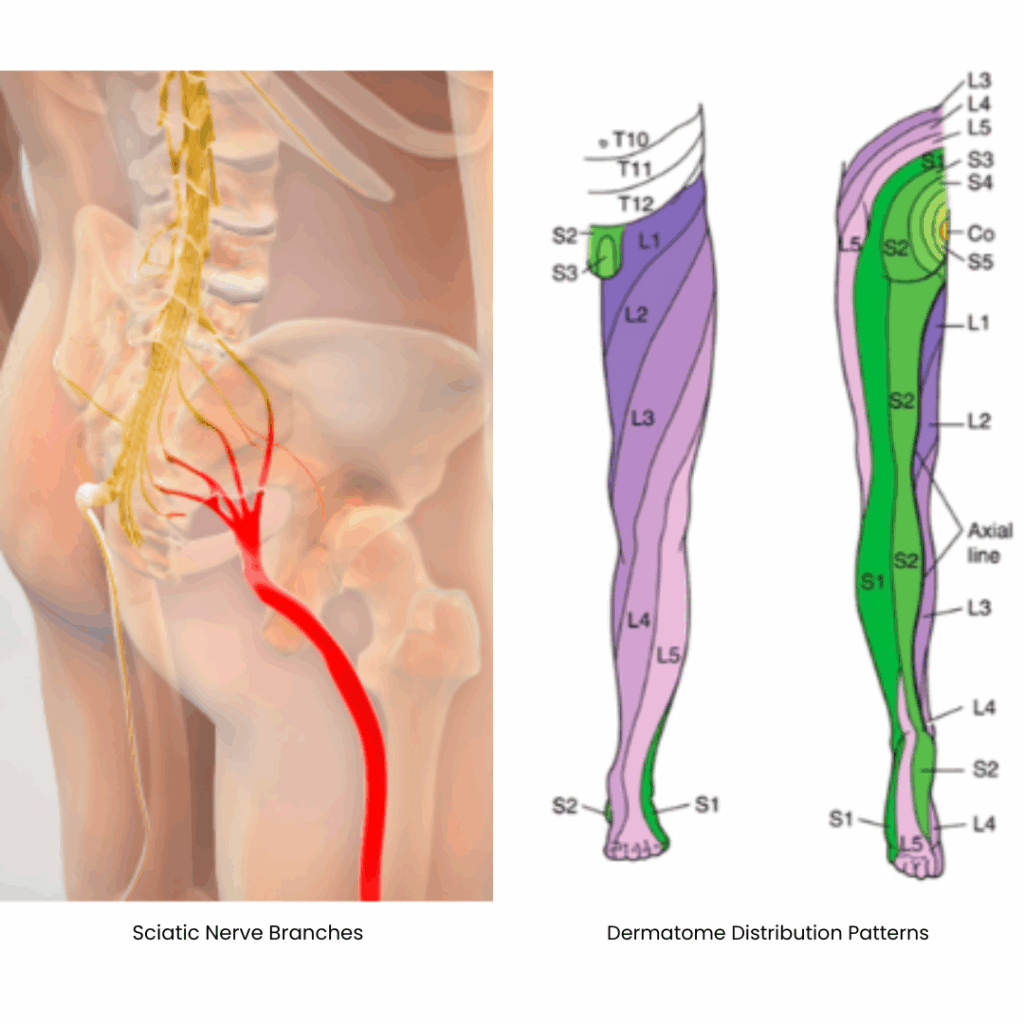Sciatica is a significant issue for many clients I see in my clinic. Almost everyone has heard the term “sciatica”, even if they haven’t experienced it themselves. However, the symptom can present in several different ways, each reflecting a different underlying pathology. Think of it as the good, the bad, and the ugly!
The Sciatic Nerve
Let’s start with the sciatic nerve. It is formed by the confluence of several spinal nerves exiting the spinal cord in the lumbosacral area (specifically L4–S3). Think of it like several streams merging into a single river.

The sciatic nerve carries information between the brain and either the left or right lower limb, particularly the posterior and medial thigh, the back of the calf, and the bottom of the foot. The area where pain is felt depends on which nerve root(s) are affected, and this is typically mapped using dermatome charts. These can vary from person to person.
Causes of Sciatic Pain
Sciatica is pain caused by irritation of the sciatic nerve directly or by compression of one or more of its nerve roots. It usually presents as pain or pins and needles down the back or side of the leg, often combined with weakness in the hamstring muscles and parts of the foot. Reflexes may also be affected, which indicates a disruption in how effectively the brain is communicating with the limbs.
So, what are the possible factors that can irritate the sciatic nerve or its nerve roots?
1. Disc Protrusion or Herniation
Each vertebra in the spine (excluding the sacrum) is separated by a disc, a tough, jelly-filled structure bonded to the vertebrae above and below. These discs cushion the spine, allow movement, and create space for nerve roots to exit the spinal cord.
If abnormal pressure is placed on the disc, its outer walls may weaken and allow the gel-like nucleus to bulge out, pressing on a nearby nerve.

This is known as a herniated disc (commonly but inaccurately referred to as a “slipped disc”). I dislike the term “slipped disc” for two reasons. First, discs are firmly bonded to the vertebrae and cannot simply “slip.” Second, it creates a misleadingly simplistic view of spinal anatomy, implying the issue can be easily pushed back into place.
In reality, a herniated disc is an injury that takes time to heal, a minimum of four weeks, though it can take six months or more. Maintaining spinal stability is essential to allow the herniated material to recede. If the herniation is unstable and breaks off, the body may reabsorb it. However, this often leaves the disc thinner and more susceptible to degenerative changes (such as arthritis) over time.
2. Stenosis
Stenosis occurs when the space between two or more vertebrae narrows to the point that bone begins to compress a nerve. As discussed above, disc compression or dehydration, often caused by age-related changes, can contribute to this narrowing.
This is a more complex condition to manage because a degenerated disc cannot simply be “plumped up.” Treatment typically includes therapy to improve spinal alignment, surgical intervention to remove encroaching bone or tissue, or steroid injections to reduce pain and inflammation.

3. Facet Syndrome
The facet joints, located at the back of each vertebra, can become inflamed if the spine is misaligned. When inflamed, these joints release chemicals that can irritate nearby nerves, leading to pain that radiates along the sciatic nerve.
4. Piriformis Syndrome
he sciatic nerve passes beneath a muscle in the pelvis called the piriformis. When this muscle becomes overly tight, often due to poor pelvic alignment or mechanical tension, it can compress the sciatic nerve and radiate pain down the leg. Most commonly, this pain is felt in the buttock and hamstring region.

These are the primary causes I evaluate when patients present with sciatic pain in my clinic. As mentioned earlier, diagnosis is rarely straightforward, and recovery isn’t a quick fix. There are other contributing factors as well, but these four are among the most common.
I hope this overview provides some useful insight.
If you have any questions, please don’t hesitate to email me.
All Photos by Cleveland Clinic





